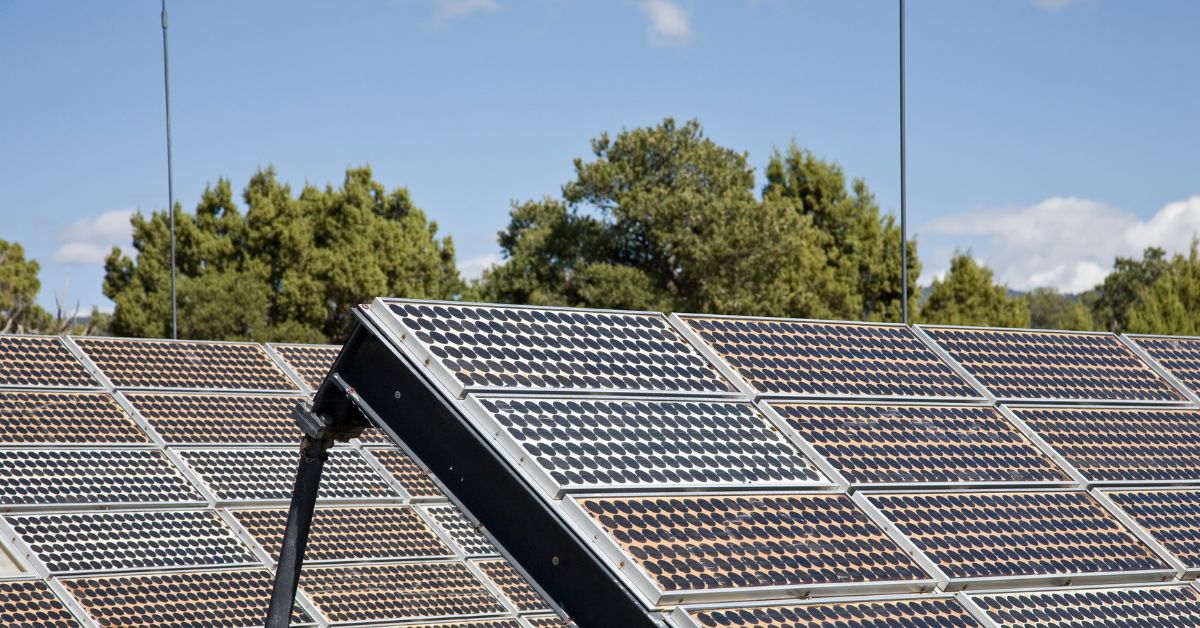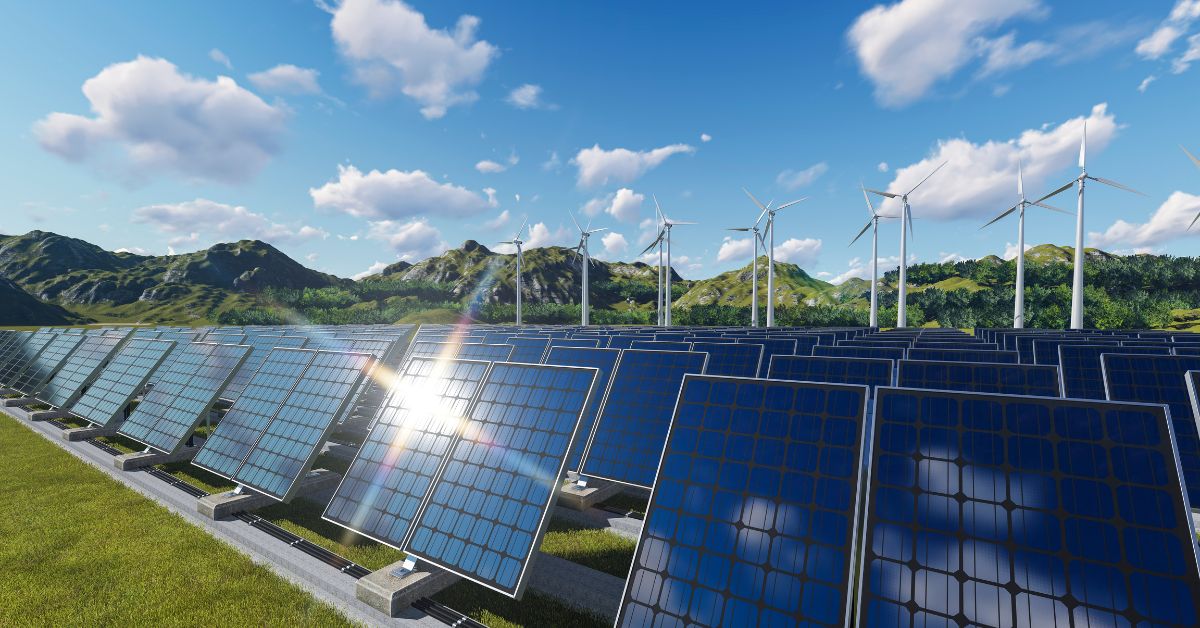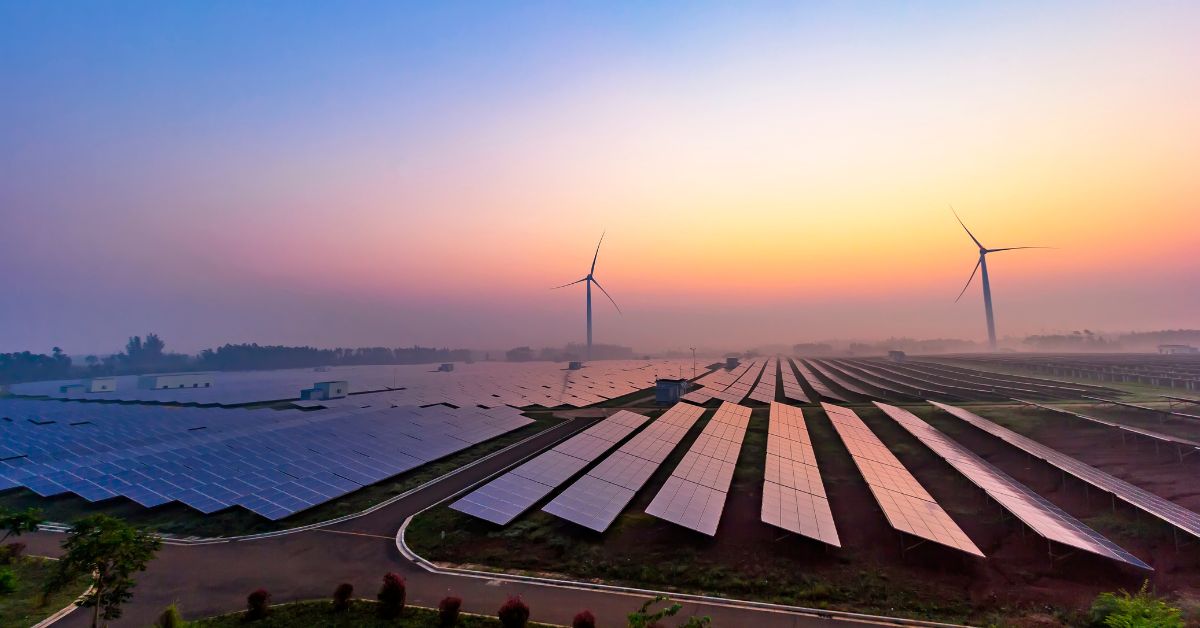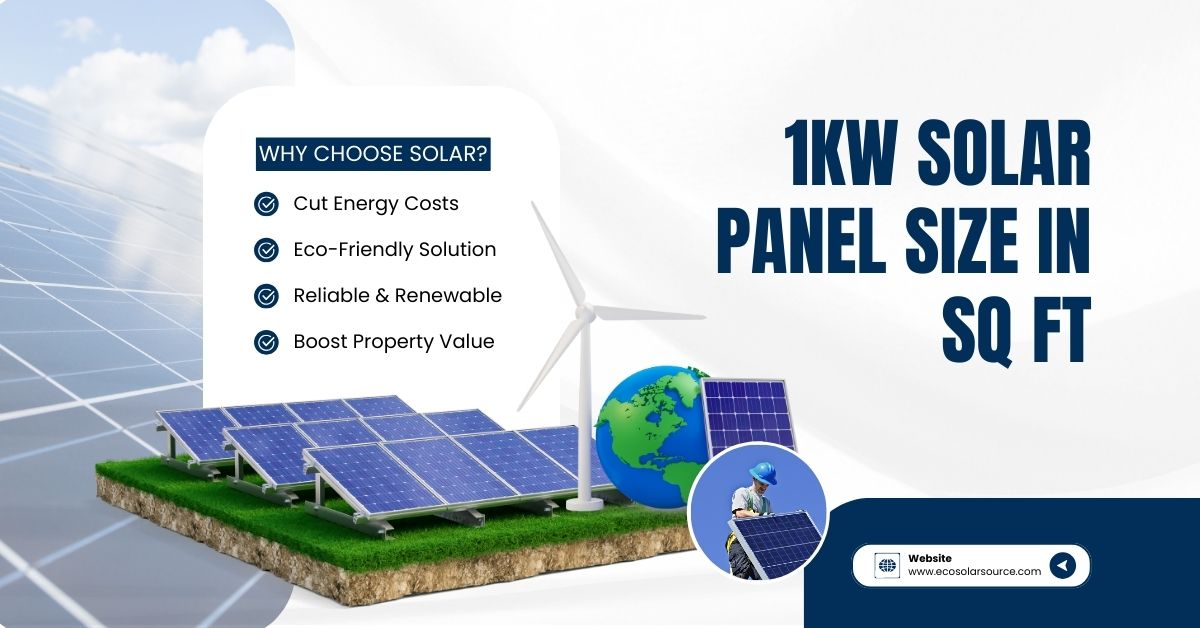1kw Solar Panel Size in SQ FT
Know the details about 1kW Solar Panel Size in SQ FT, A 1kW solar panel system typically requires around 65 to 100 square feet of space, depending on the efficiency of the panels. High-efficiency panels need less space, approximately 65 to 75 square feet, while standard-efficiency panels might need closer to 90 to 100 square feet.
This space requirement ensures optimal sunlight exposure, allowing the panels to generate around 4 to 5 units of electricity per day, depending on location and weather conditions. A 1kW system is ideal for small households or businesses with low energy consumption, providing a sustainable solution for reducing electricity bills and carbon footprint.
Table of Contents
1 kW Solar Panel Size in SQ FT: Everything You Need to Know
Solar energy has become an essential part of sustainable living as more people turn to renewable energy sources to power their homes and businesses. Among the many forms of renewable energy, solar power stands out for its accessibility and the declining costs of installation. For those considering installing solar panels, one of the most common questions is: How much space does a 1 kW solar panel system require? Understanding the size of a 1 kW solar panel system in square feet is crucial for planning and installing the right system for your needs.
In this comprehensive guide, we’ll dive deep into the topic, covering everything from the basic principles of solar energy to the factors affecting the size of a 1 kW solar panel system. We’ll also explore the practical considerations when installing these panels on rooftops or in ground-mounted systems.
Understanding Solar Power and Kilowatts (kW)
Before diving into how much space a 1 kW solar panel system requires, it’s essential to understand some basics about solar power and the concept of kilowatts.

Solar Energy Basics:
Solar panels work by converting sunlight into electricity through photovoltaic (PV) cells. When sunlight hits to the PV cells, it excites electrons, creating a flow of the electricity. This electricity is then used to power homes, and businesses, or is stored in batteries for later use.
What is a Kilowatt (kW)?
A kilowatt is a unit of power equivalent to 1,000 watts. When we refer to a 1 kW solar panel system, we mean a system capable of producing 1 kilowatt of electricity under ideal conditions (when the sun is shining directly on the panels).
Why Focus on 1 kW Systems?
1 kW systems are often the benchmark for small-scale solar installations. These systems are popular because they’re suitable for modest energy needs and provide a clear reference point for understanding solar power sizing and installation space.
What is a 1 kW Solar Panel System?
A 1 kW solar panel system typically consists of several solar panels connected to generate 1 kilowatt of electricity. How many panels are needed, and the total space they occupy, depends on several factors like panel efficiency, type, and installation angle.
On average, a 1 kW system might generate around 4-5 kilowatt-hours (kWh) of electricity per day, depending on location, sun exposure, and other factors. The actual energy output varies based on:
- Geographic location
- Weather conditions
- Shading and obstructions
In terms of energy consumption, a 1 kW system might be sufficient for powering basic home appliances like lights, fans, and small electronics, but it won’t suffice for a household’s entire energy needs.
Solar Panel Advantages and Disadvantages
| Advantages | Disadvantages |
|---|---|
| 1. Renewable Energy Source | 1. High Initial Costs |
| Solar panels use the sun’s energy, an abundant and infinite resource. | Installation and setup can require significant upfront investment. |
| 2. Reduces Electricity Bills | 2. Weather Dependent |
| Once installed, they lower electricity costs, sometimes even eliminating them. | Solar power generation is less effective during cloudy or rainy days. |
| 3. Low Maintenance Costs | 3. Energy Storage Costs |
| Solar panels require minimal maintenance, reducing ongoing expenses. | Storing solar energy for nighttime use requires expensive batteries. |
| 4. Environmentally Friendly | 4. Requires Space |
| They reduce carbon emissions, helping to combat climate change. | Solar panel systems take up significant roof or land space. |
| 5. Diverse Applications | 5. Intermittent Energy Production |
| Solar energy can be used in many ways, including heating, electricity, and more. | Solar power is not continuous, only available when the sun shines. |
| 6. Technology Development | 6. Energy Conversion Efficiency |
| Solar technology is improving, making systems more efficient and affordable. | Conversion efficiency of solar panels is still lower compared to other energy sources. |
| 7. Long Lifespan | 7. Recycling Challenges |
| Solar panels have a lifespan of 20-25 years or more. | Recycling used solar panels can be complicated and costly. |
| 8. Increases Property Value | 8. Aesthetic Impact |
| Homes with solar panels often have higher resale values. | Solar panels can alter the appearance of a property. |
| 9. Energy Independence | 9. Dependence on Location |
| Solar panels reduce reliance on external energy sources, increasing energy security. | The conversion efficiency of solar panels is still lower compared to other energy sources. |
| 10. Government Incentives | 10. Installation Complexity |
| Many governments offer tax credits or incentives to adopt solar energy. | Installation requires professional expertise, adding complexity to the process. |
Key Factors That Affect Solar Panel Size
Several factors determine the size of the solar panel system you’ll need for 1 kW of power, including:

- Panel Efficiency: Different types of solar panels have varying efficiency rates. The more efficient the panel, the less space it requires.
- Technology Used: Polycrystalline, monocrystalline, and thin-film panels all have different sizes and efficiencies.
- Sunlight Availability: The amount of sunlight your location receives affects how much space is needed. Areas with more sunlight may require fewer panels to generate 1 kW of power.
- Installation Angle and Orientation: The way panels are angled and oriented can affect their overall footprint.
1 kW Solar Panel Size in Square Feet
To estimate the size of a 1 kW solar panel system in square feet, you need to consider the type of panel and its efficiency. On average, most solar panels are around 15-20% efficient, meaning they convert 15-20% of the sunlight that hits them into usable electricity.
Here’s a rough estimate of how much space you might need:
- Low-efficiency panels (15%): Around 100 square feet
- Medium-efficiency panels (17-19%): Around 80-90 square feet
- High-efficiency panels (20-22%): Around 60-70 square feet
In terms of panel size, most standard solar panels today are about 65 inches by 39 inches, or roughly 17.5 square feet per panel. Depending on the type and efficiency of the panels, a 1 kW system may require anywhere from 3 to 6 panels.
How to Calculate the Space Required:
If you know the efficiency of the panels you plan to install, you can calculate the approximate space requirement using this formula: Area Required (sq ft)=1,000Efficiency %×Panel Wattage×Panel Size (sq ft)\text{Area Required (sq ft)} = \frac{1,000}{\text{Efficiency \%} \times \text{Panel Wattage}} \times \text{Panel Size (sq ft)}Area Required (sq ft)=Efficiency %×Panel Wattage1,000×Panel Size (sq ft)
For example, if you are using 300-watt panels with 18% efficiency, the formula would look like this: Area Required=1,0000.18×300×17.5=82 square feet\text{Area Required} = \frac{1,000}{0.18 \times 300} \times 17.5 = 82 \text{ square feet}Area Required=0.18×3001,000×17.5=82 square feet
Types of Solar Panels and Their Impact on Size
Solar panels come to three main types: monocrystalline, polycrystalline, and thin film. Each has its impact on the overall size of the 1 kW system.
Monocrystalline Solar Panels
- Efficiency: High (18-22%)
- Space Requirement: Least (around 65-80 sq ft for 1 kW)
- Pros: Most efficient, longer lifespan, best for limited space.
- Cons: More expensive than other types.
Polycrystalline Solar Panels
- Efficiency: Medium (15-18%)
- Space Requirement: Moderate (80-100 sq ft for 1 kW)
- Pros: Cheaper than monocrystalline, decent efficiency.
- Cons: Larger space requirement for the same power output.
Thin-Film Solar Panels
- Efficiency: Low (10-12%)
- Space Requirement: High (120+ sq ft for 1 kW)
- Pros: Lightweight, flexible, good for specific use cases like portable installations.
- Cons: Requires more space, less efficient, shorter lifespan.
Rooftop vs. Ground-Mounted Solar Systems
The space required for a 1 kW solar system will also depend on whether you’re installing the system on a rooftop or as a ground-mounted array.
Rooftop Systems
Rooftop systems are popular in residential settings due to space limitations. The size of your roof is a critical factor when considering a solar installation. Roofs with plenty of unobstructed space, minimal shading, and good exposure to sunlight are ideal.
Ground-Mounted Systems
If you have a large property or farmland, ground-mounted systems provide more flexibility for orientation and space. They can be angled more easily to maximize efficiency and ensure proper ventilation around the panels, which can boost performance. However, they require more space than rooftop systems, and additional costs might be incurred for the mounting structures.
Calculating Space Requirements for Solar Panels
As noted earlier, you can calculate the space needed for a 1 kW system based on panel size, efficiency, and available sunlight. Let’s break it down step-by-step:

- Panel Efficiency: Determine the efficiency of the panels you plan to use. For most residential installations, monocrystalline panels (18-22%) are a popular choice because of their space-saving properties.
- Panel Size: Measure the dimensions of the solar panels. Standard sizes range from 17-21 square feet per panel.
- Total Power Output: Calculate how many panels are needed to achieve 1 kW of power. For example, using 300-watt panels, you’d need around 3-4 panels.
- Total Area: Multiply the number of panels by their size to determine the total area required in square feet.
Example Calculation: If you’re using 300-watt monocrystalline panels with an efficiency of 19%, and each panel measures around 17.5 square feet, the space required for 1 kW would be: Panels Required=1,000300=3.33 panels\text{Panels Required} = \frac{1,000}{300} = 3.33 \text{ panels}Panels Required=3001,000=3.33 panels Area Required=3.33×17.5≈58 square feet\text{Area Required} = 3.33 \times 17.5 \approx 58 \text{ square feet}Area Required=3.33×17.5≈58 square feet
Other Factors to Consider (Tilt, Spacing, Shading)
When calculating the required space, it’s important to account for more than just the raw size of the panels. Here are other factors that can affect how much area you’ll need:
- Panel Tilt: If you install your panels at an angle, this will require more space than flat installations. Panels should typically be tilted to match your latitude for optimal performance.
- Spacing Between Panels: It’s crucial to leave adequate spacing between panels for maintenance and airflow. This space allows heat to dissipate, which improves panel performance.
- Shading: Avoiding shade from trees, buildings, or other obstructions is critical for maximizing energy production. Ensure there is enough space to position the panels in a way that minimizes shading throughout the day.
Efficiency and Performance of 1 kW Systems
While the physical size of the panels is important, so too is the system’s efficiency and performance. A high-efficiency 1 kW system can produce more power in less space, but performance also depends on factors like:
- Location: Solar panels in sunnier locations will produce more power.
- Time of Year: Solar energy production is typically higher in the summer.
- Maintenance: Keeping the panels clean and free of debris will ensure they operate at peak efficiency.
FAQs About 1kw Solar Panel Size in SQ FT
Q1. How much space is required for a 1 kW solar panel system?
A typical 1 kW solar panel system requires approximately 80 to 100 square feet of area, depending on the efficiency and type of solar panels used.
Q2. What is the average size of an individual solar panel in square feet?
The average size of a standard solar panel is around 17 to 20 square feet (usually about 5.5 to 6.5 feet long and 3.5 feet wide).
Q3. Can a 1 kW solar panel system fit on a small rooftop?
Yes, a 1 kW system can fit on a small rooftop with an area of around 100 square feet, making it ideal for small homes or limited roof spaces.
Q4. Does panel efficiency affect the square footage needed for a 1 kW system?
Yes, more efficient solar panels (e.g., monocrystalline) require less space, while lower efficiency panels (e.g., polycrystalline) need more space for the same 1 kW output.
Q5. Is it necessary to leave extra space around the panels for a 1 kW system?
It’s advisable to leave some space around the solar panels for maintenance and airflow, but the total area for a 1 kW system will generally not exceed 100-120 square feet.
Q6. Does the tilt angle of solar panels affect the space needed?
Yes, the tilt angle might affect how panels are arranged, but it usually doesn’t significantly increase the square footage needed, though it might vary slightly.
Q7. How many solar panels are needed for a 1 kW system, and what is their combined area?
A 1 kW system typically consists of 3 to 4 panels, each covering around 17-20 square feet. Combined, they will cover about 80 to 100 square feet.
Q8. Do shading and obstruction-free space impact the size required for 1 kW solar panels?
Yes, the space should be free from shading and obstructions, but this doesn’t change the square footage needed—just the quality of solar output.
Q9. Can I install a 1 kW system on my balcony or terrace?
If your balcony or terrace offers a minimum of 80 square feet of sunlight-exposed area, you can install a 1 kW system. Make sure it’s structurally feasible.
Q10. Is the square footage different for ground-mounted vs. rooftop solar for a 1 kW system?
The square footage for a 1 kW system is similar for both ground-mounted and rooftop setups, but ground-mounted systems may require more spacing for maintenance access.
Conclution
In conclusion, the space required for a 1 kW solar panel system varies based on several factors, including panel efficiency, type, and installation method. On average, you can expect to need between 60 to 100 square feet for a 1 kW system, but this can vary depending on the specific panels and your location.
Whether you’re planning to install panels on your rooftop or as a ground-mounted system, it’s essential to calculate the required space accurately. High-efficiency panels may cost more upfront but can save you space and increase overall energy production. Proper installation, maintenance, and consideration of factors like tilt and shading will further optimize the performance of your solar power system.
By understanding the space requirements and factors involved, you’ll be better equipped to plan and install the perfect solar panel system for your home or business.
Click here to learn more about 1kw Solar Panel Size in SQ FT
Click here to learn more about India Leads The Way in Renewable Energy With 175 Rise

